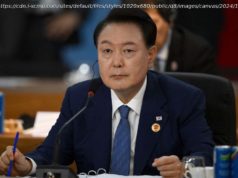Shorthanded after 2016 death of Antonin Scalia, court largely avoided controversial topics
WASHINGTON — The Supreme Court begins its new term Monday (Oct. 2) with a fortified conservative majority and a docket filled with some of the moment’s most contentious issues: voting rights, religious liberty, protection from discrimination and privacy in an increasingly monitored society. The court was shorthanded for more than a year after the death of Justice Antonin Scalia in February 2016 and responded by largely avoiding controversial topics and compromising to reach narrow, consensus decisions.
Now Justice Neil Gorsuch is not only filling Scalia’s seat but also matching his conservative ideological role on the court. With the court back to its full nine members, it has a docket that will test harmony.
“We’ve heard the last term described as the calm before the storm,” said Ian Heath Gershengorn, the acting solicitor general under President Barack Obama . “I think we may get to see the storm in this next sitting.”
Justice Ruth Bader Ginsburg told Georgetown University law students recently: “There is only one prediction that is entirely safe about the upcoming term, and that is it will be momentous.”
A trio of cases that will likely be heard before the end of the year forms the nucleus. At issue:
David Cole, legal director of the American Civil Liberties Union, was referring to those three cases when he said, “At the broadest level, the court has cases that will shape the future of democracy, privacy and equality.”
But beyond examining the rulings, those who study the Supreme Court will be evaluating how the nine justices — Gorsuch joined the court last April at the end of its oral arguments — conduct themselves in their first full term together. With every new justice, the late Justice Byron White liked to say, it’s a new court.
“I’m going to be watching early on to see how the court reintroduces itself back to the country in the midst of the current political spitballing otherwise enveloping Washington,” said Jeffrey Fisher, a Stanford University law professor who frequently argues cases before the Supreme Court.
“Will the court present itself as the grown-ups in the room, or will it, in a sense, join the ideological battle?” He added: “No governmental institution has a more profound interest in preserving its own legitimacy and the overall concept of separation of powers.”
Perhaps because Americans are comparing it to the combustible President Donald Trum p and the gridlocked Congress — both with approval ratings underwater — a recent poll shows the public’s trust in the federal judicial branch increasing to 68 percent. For the first time in almost a decade, more Americans (30 percent) think the Supreme Court is too conservative than think it is too liberal (23 percent), according to Gallup. The pollsters say Americans’ perceptions of the ideological leaning of the court are likely influenced by the current president’s political party and the justices he appoints.
Justice Anthony Kennedy remains the court’s pivotal justice; in the most recent term, he was in the majority 97 percent of the time, more than any other justice. He is likely to be the deciding vote in the partisan gerrymandering case and the case of the baker who refused to make a cake for a gay couple, as well as in a host of other disputes.
Kennedy most often sides with the court’s conservatives. But it is almost always true that liberal victories are possible only with Kennedy’s help.
There will be two compelling questions about him this term.
One is whether it will be his last term. There were (mostly unsubstantiated) rumors that Kennedy, 81 and the court’s longest-serving member, considered retiring last term. If this is it, it could affect how hard interest groups push to get issues on the court’s docket now.
“I think there are a lot of people who are trying to get cases to the court because they think this is a court that more favorable to their positions than would be there if they let the issues percolate longer,” said Pamela Karlan, co-director of the Stanford Supreme Court Litigation Clinic. One example: whether federal anti-discrimination protections cover sexual orientation, an issue on which lower courts are divided. Kennedy has written all of the court’s major gay rights decisions.
There is also speculation about whether Gorsuch might have an effect on Kennedy, for whom he clerked in 1993 and 1994. It’s the first time a clerk has joined his former boss on the court.
“Perhaps the most interesting, and impactful, question going into this term is whether Justice Gorsuch will succeed as others haven’t in holding his former boss in a firm conservative majority or whether a strong, new conservative voice on the court in a Justice Gorsuch might actually push Justice Kennedy to the left,” said Gregory Garre, solicitor general under President George W. Bush.
For his part, Gorsuch in a recent law school appearance denied any special insight. “As far as reading his mind — I don’t purport to read any of my colleague’s minds,” Gorsuch said. “I read their opinions.”
Based on the scant evidence from last year’s term, Gorsuch seemed more ideologically aligned with Thomas and Justice Samuel Alito Jr., the court’s most conservative members. “The budding bro-mance” between Gorsuch and Thomas bears watching, said Washington lawyer Helgi Walker, a former Thomas clerk.
The third major player this term will be Chief Justice John Roberts Jr. “He may have the most difficult job,” Garre said. “After a year and a half period in which the justices seemed to go to extraordinary lengths to achieve some form of consensus, the environment is ripe for internal friction if the court falls back into a more conventional 5-4 line up in the biggest cases.”
Also looming: Trump. The court has put aside for now a scheduled oral argument on the president’s executive order banning travel from six mostly Muslim countries, since a new order was put in place last month.
But a confrontation between Trump and the court feels inevitable to Stanford’s Fisher. “Perhaps at first only in a tweet but perhaps also ultimately in some kind of refusal to abide by a court decision,” he said. “Such a moment would bring a dramatic constitutional showdown of the sort not seen at the federal level for almost 200 years, or even at the state level since desegregation battles of the mid twentieth century.”
The court will accept cases through January to fill out the term’s docket. These are some of the most important accepted so far:
Masterpiece Cakeshop v. Colorado Civil Rights Commission — Baker Jack Phillips in 2012 refused to create a cake for a reception that Charlie Craig and David Mullins had planned to celebrate their wedding in Massachusetts. Phillips told the couple that his religious beliefs did not let him participate in a celebration of same-sex marriage.
The civil rights commission and a Colorado court found Phillips violated a state law requiring businesses serving the public not to discriminate based on, among other things, sexual orientation.
The Trump administration is backing his assertion that his cakes are an artistic expression, and that forcing him to comply would violate his right to free speech. The state, however, says an observer would see only that Phillips is complying with the law and that the cake is not his speech.
Gill v. Whitman — Did the Republicans in control of Wisconsin’s legislature and governor’s office draw election redistricting maps so skewed in the party’s favor that they violate the Constitution?
While the Supreme Court regularly makes states redraw maps that are found to be racially gerrymandered, the justices have never agreed on a standard that would disallow extreme partisan gerrymandering.
Home
United States
USA — Criminal 'It will be momentous': Supreme Court embarking on new term with full...






